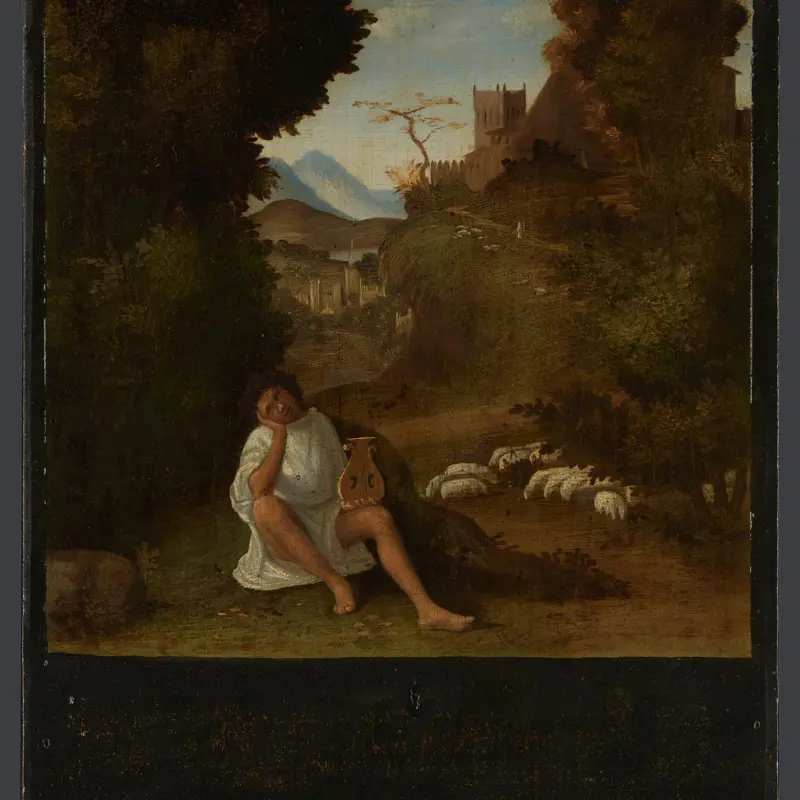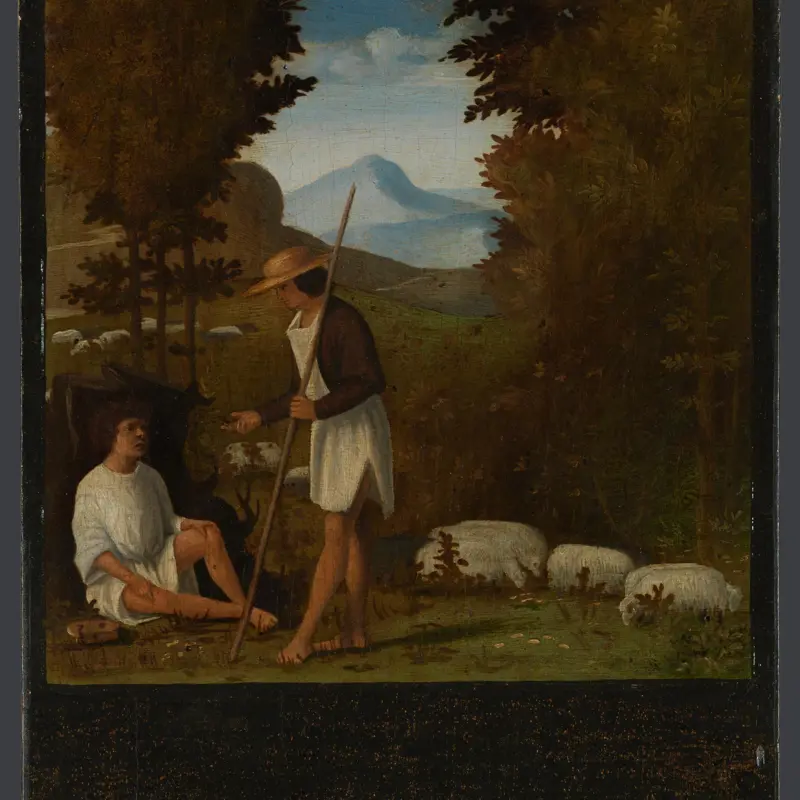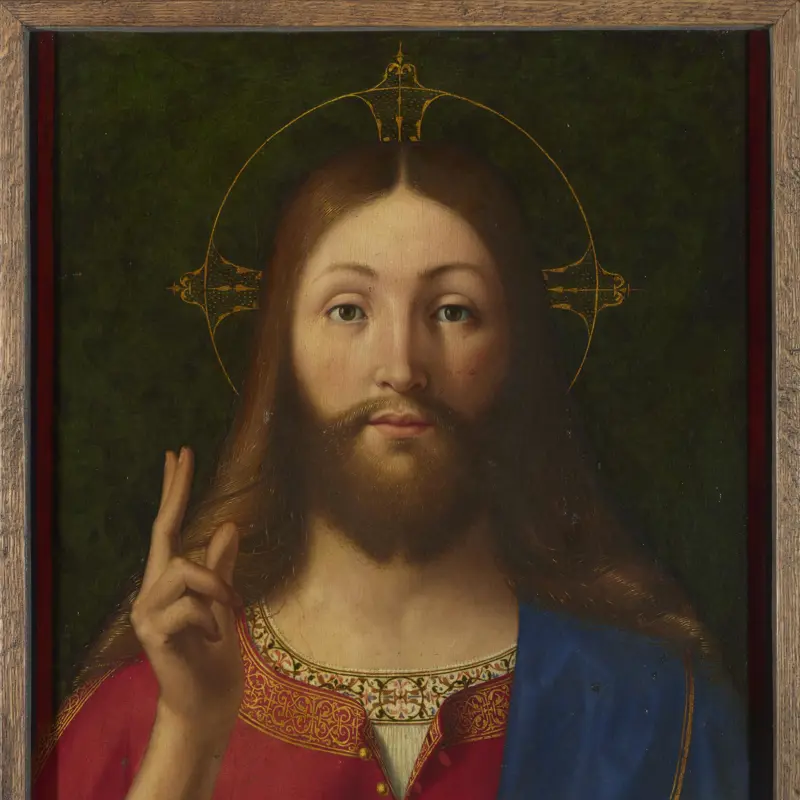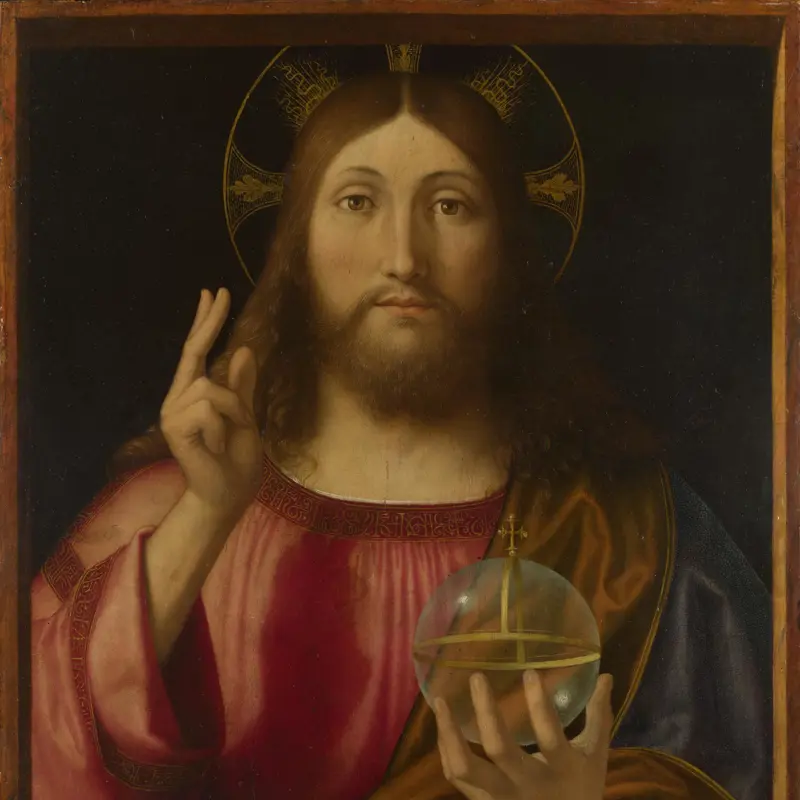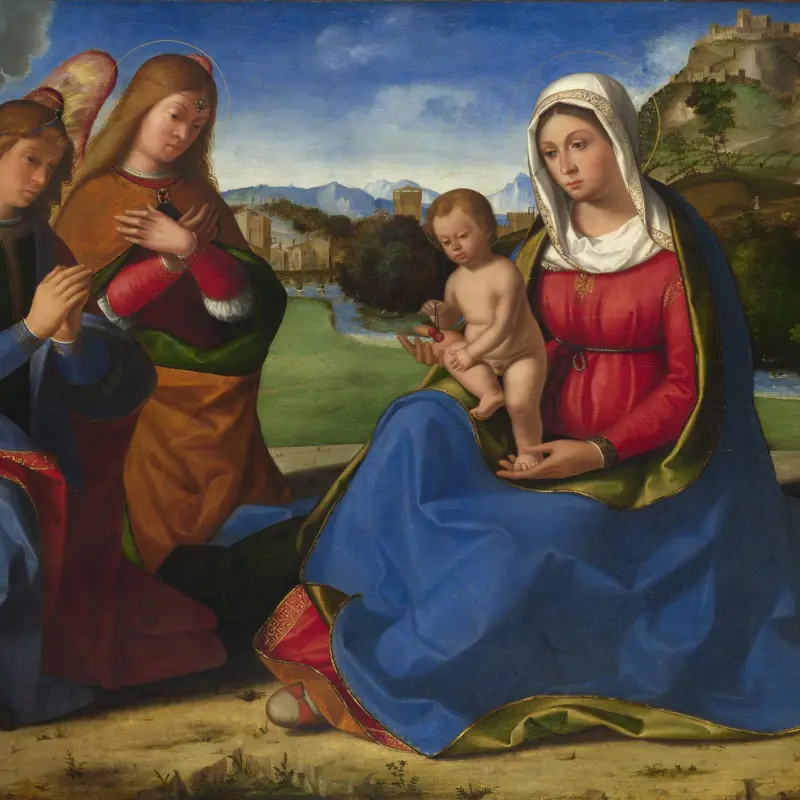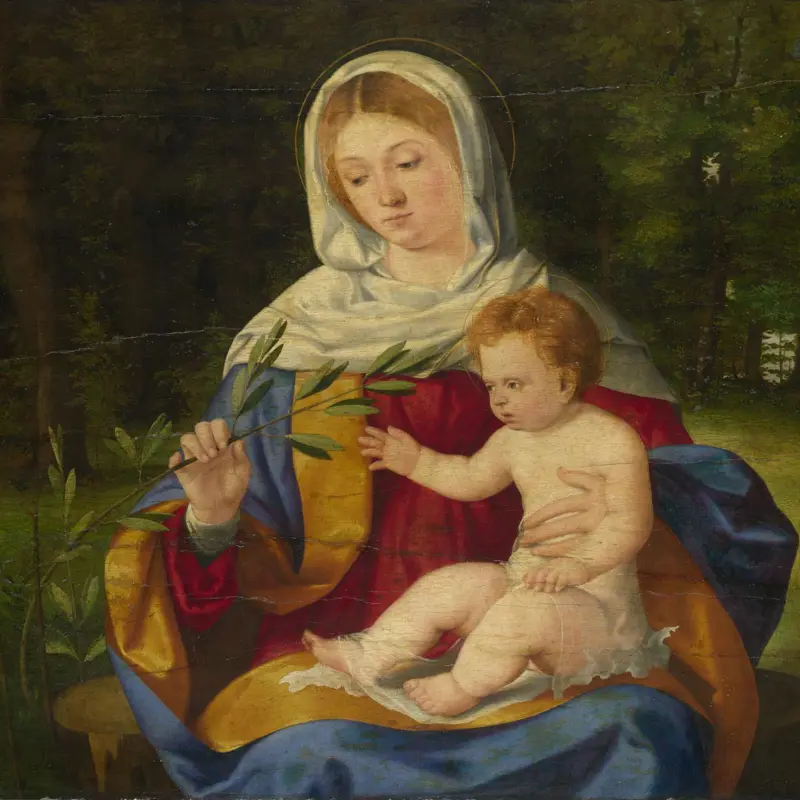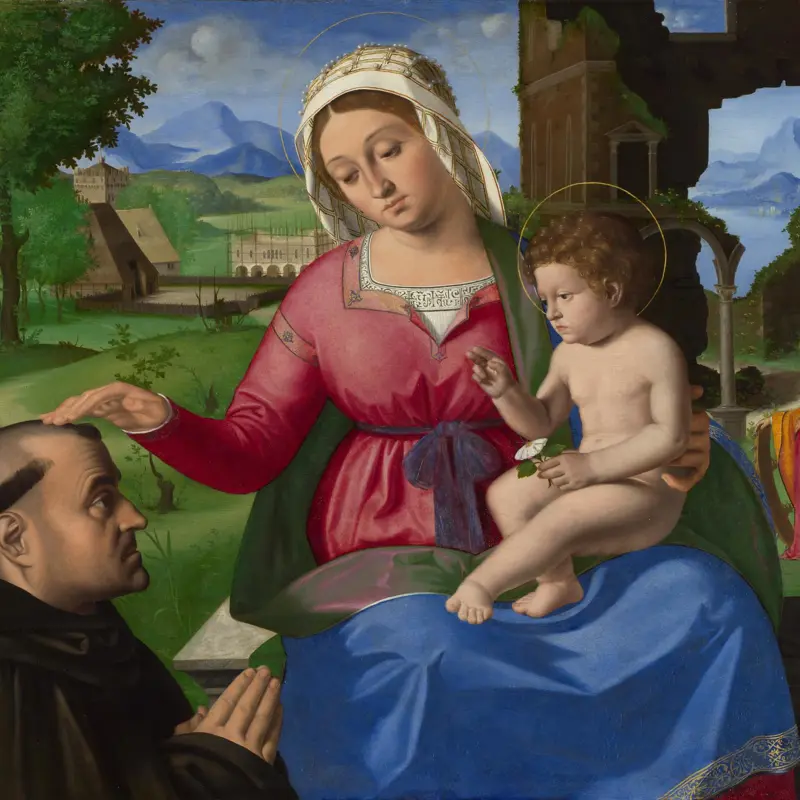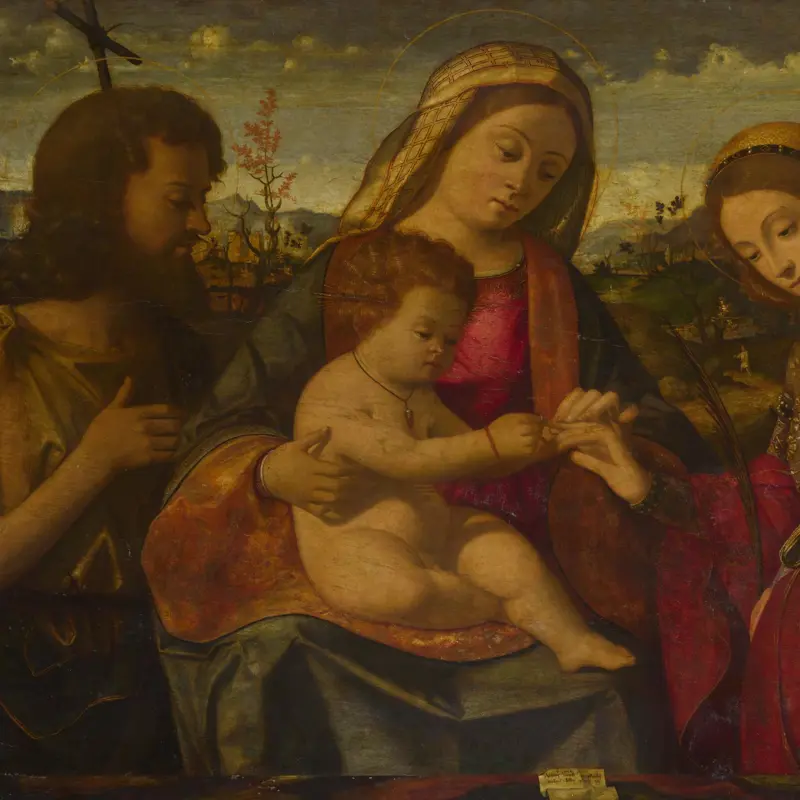Andrea Previtali, 'Scenes from Tebaldeo's Eclogues: The Story of Damon', about 1510
About the work
Overview
These two small paintings are part of a group of four scenes, which are painted on two wooden panels. They would once have decorated a piece of furniture, perhaps the case of a musical instrument. They illustrate key scenes from Tebaldeo’s popular Second Eclogue, first printed in Modena in 1498. The first and third scenes are represented on this panel: Damon broods on his Unrequited Love and Damon takes his Life.
In the first scene the young shepherd, Damon, sits on the ground with his head in his hand, thinking about his unrequited love for Amaryllis. He has stopped playing his lyre and ignores his flock of sheep. In the third scene, Damon is in a rugged, desolate landscape with a lake or shore in the middle distance. We see the moment he plunges the dagger into his chest in despair. A stream of blood pours from the wound, while his lyre lies broken at his feet.
Key facts
Details
- Full title
- Scenes from Tebaldeo's Eclogues: Damon broods on his Unrequited Love / Damon takes his Life
- Artist
- Andrea Previtali
- Artist dates
- about 1480 - 1528
- Part of the group
- Scenes from Tebaldeo's Eclogues
- Date made
- about 1510
- Medium and support
- oil on wood
- Dimensions
- 45.2 × 19.9 cm
- Acquisition credit
- Bought with a contribution from the Art Fund, 1937
- Inventory number
- NG4884.1
- Location
- Not on display
- Collection
- Main Collection
- Frame
- 21st-century Replica Frame
Provenance
Conte Luigi Da Porto, Schio, near Vicenza. Sold in the summer of 1936 to ‘Podio’, exported to Austria (perhaps via Czechoslovakia). With Oskar Salzer in Vienna when shown to Kenneth Clark by Leo Planiscig in April 1937. Bought after a special meeting of the Trustees on 6 July 1937 for £14,000, with a contribution of £2,000 from the National Art Collections Fund. A receipt from Salzer dated 9 July also includes a ‘guarantee that the said pictures have been exported from Austria with proper legal sanction and that I had full authority to sell them’.
Confirmation that the paintings come from the Da Porto family has kindly been supplied by Dott. Francesco da Schio, whose cousin Loredana, daughter of Conte Luigi, recalls their presence in the family collection. It is very likely that they were in the Da Porto family’s possession for half a century. The rumour that they were acquired from the Manfrin Collection may be the result of a confusion with other works in the Da Porto Collection. Certainly the pictures do not correspond to any of the items described in the catalogues of that collection (the source of so many Giorgiones and possible Giorgiones). Previtali’s Virgin and Child with a Donor now in the Wadsworth Atheneum also came from the Da Porto Collection (before 1910, when it belonged to ‘Yerkes’). An earlier sale from this collection was Mantegna’s Virgin and Child, presented to the Gemäldegalerie, Berlin, in 1904 by James Simon.
Additional information
This painting is included in a list of works with incomplete provenance from 1933–1945; for more information see Whereabouts of paintings 1933–1945.
Text extracted from the ‘Provenance’ section of the catalogue entry in Nicholas Penny, ‘National Gallery Catalogues: The Sixteenth Century Italian Paintings’, vol. 1, ‘Paintings from Bergamo, Brescia and Cremona’, London 2004; for further information, see the full catalogue entry.
Exhibition history
-
2010Close Examination: Fakes, Mistakes and DiscoveriesThe National Gallery (London)30 June 2010 - 12 September 2010
-
2013Pietro Bembo e l'invenzione del RinascimentoFondazione Cassa di Risparmio di Padova e Rovigo2 February 2013 - 19 May 2013
-
2014Kenneth ClarkTate Britain19 May 2014 - 10 August 2014
-
2018Albrecht Dürer and the Renaissance between Germany and ItalyPalazzo Reale (Milan)21 February 2018 - 24 June 2018
Bibliography
-
1938National Gallery, National Gallery and Tate Gallery Directors' Reports, 1937, London 1938
-
1959Gould, Cecil, National Gallery Catalogues: The Sixteenth Century Venetian School, London 1959
-
1986Davies, Martin, National Gallery Catalogues: The Earlier Italian Schools, revised edn, London 1986
-
2001
C. Baker and T. Henry, The National Gallery: Complete Illustrated Catalogue, London 2001
-
2004
Penny, Nicholas, National Gallery Catalogues: The Sixteenth Century Italian Paintings, 1, Paintings from Bergamo, Brescia and Cremona, London 2004
Frame
This is a twenty-first-century reproduction frame, made from walnut. It was inspired by the period frame paired with Andrea Mantegna’s The Introduction of the Cult of Cybele at Rome, which formed part of a Renaissance cassoni.
The walnut mouldings are affixed to a poplar wood back frame, with the sides also encased in walnut.
About this record
If you know more about this work or have spotted an error, please contact us. Please note that exhibition histories are listed from 2009 onwards. Bibliographies may not be complete; more comprehensive information is available in the National Gallery Library.
Images
About the group: Scenes from Tebaldeo's Eclogues
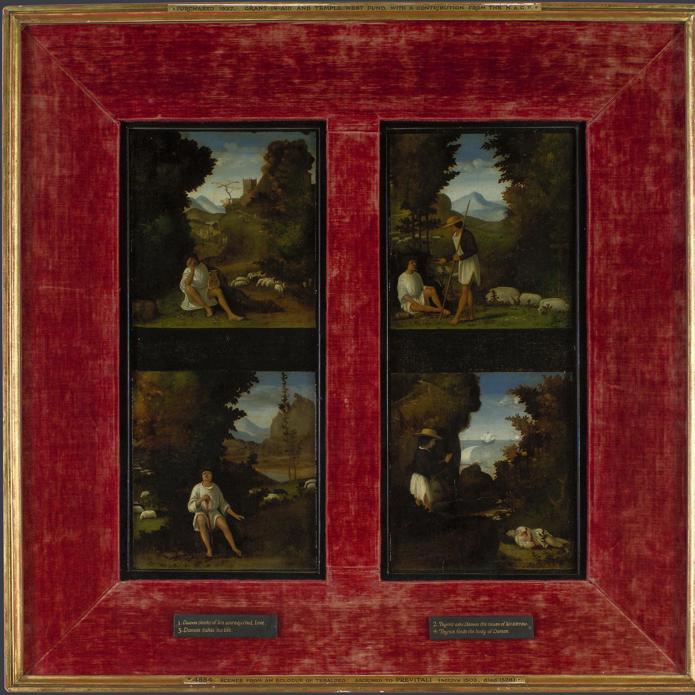
Overview
These four small pictures were probably painted for a piece of furniture, perhaps the case of a musical instrument. They illustrate the key episodes of the Second Eclogue by Antonio Tebaldeo (1456–1538), a poet from Ferrara.
In the first scene the shepherd Damon broods over his unrequited love for Amaryllis. He neglects his sheep, stops playing his lyre and rests his head in his hand. In the next scene his friend Thyrsis urges him to stop being so melancholy. In the third scene, having broken his instrument and abandoned it on the ground, Damon plunges a dagger into his chest. In the final scene, Thyrsis discovers Damon’s body.
When the paintings were acquired by the National Gallery in 1937 they were believed to be by the Venetian painter Giorgione. However, the scenes resemble other signed works by Previtali and the paintings are now thought to be by him.

